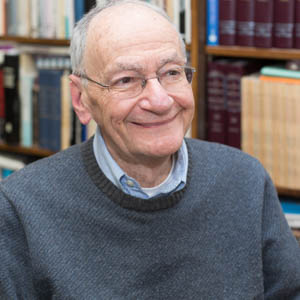The Theology of the Jewish Calendar

Shabbat Hahodesh | Pesah
By :
Ismar Schorsch Rabbi Herman Abramovitz Distinguished Service Professor of Jewish History and Chancellor Emeritus
Posted On Apr 9, 2005 / 5765 | Torah Commentary | Holidays




With Shabbat ha-Hodesh, we are just two weeks away from the first seder. Passover does not usually fall this late in April. A leap year accounts for its delay. In the Jewish calendar, unlike the secular one, a leap year consists of adding an extra month, and there are seven such leap years within every cycle of nineteen years. The month that is doubled is Adar, the last month of the year, the one in which we celebrate Purim. Hence, in a leap year, Purim comes in the second Adar (adar sheni) and Passover, thirty one-days later.
Passover, like the other two pilgrimage festivals of Shavu’ot and Sukkot, has an agricultural base which predated its historical overlay. It is to preserve that link that the Rabbis adjusted the Bible’s lunar calendar to the solar year. Lunar calendars tend to be older because the conspicuous changes in the moon’s monthly cycle afford greater opportunity to mark time. But, the lunar year of twelve months is some eleven days shorter than the solar year. Thus, without correction, and given that the seasons are determined by the sun, the agricultural festivals of a lunar calendar would always be in flux.
Accordingly, the Rabbis interpreted the verse in Deuteronomy (16:1), “Observe the month of Abib [in which the exodus occurred] and offer a Passover sacrifice to the Lord your God.” as warranting an act of intercalation in the prior month. Rashi, in his cryptic commentary on this verse, highlights the agricultural reason: “Prior to its coming [the month of Abib], so that Abib might be ready [to provide the grain] for the grain offering sacrifice and if not, intercalate the year.” If the new crop of barley, in other words, is still not ripe for harvesting, then postpone the Hag, the pilgrimage festival. As such, the text seems determined to keep Passover agriculturally aligned. Indeed, the word Abib also means “new ears of grain” on the stalks in the field. In their absence, a leap year is called for.
The result is a calendar governed by both moon and sun, a pragmatic resolution to encompass the best of two calendrical systems out of sync. With its monthly commemoration of the new moon, Rosh Hodesh, the lunar calendar invests our sense of time with an added appreciation for nature. But, Judaism’s dual calendar goes well beyond living in two time zones. It gives expression to two dimensions of Jewish identity through the celebration of two entirely different new years.
The extra Torah portion for Shabbat ha-Hodesh opens resoundingly with a declaration of independence. The month in which Israel will be sprung from slavery is to be singled out forever as the first month of the year: “This month,” says God to Moses and Aaron in Egypt, “shall be the first of the months of the year for you” (Exodus 12:2). Today, this month is known by the name of Nisan, though in our passage the month is noticeably unnamed.
Nachmanides in his commentary (thirteenth century) on the verse stresses this underlying idea. The Torah resists adopting a nomenclature for the months. They are only referenced by ordinal numbers in relation to the first. Thus, every mention of a month, (i.e., the fifth or the seventh, for example) implicitly recalls the redemption from Egypt. That historical event gave birth to the nation of Israel and its special covenant with God. All that follows thereafter is contingent, a contingency symbolized by relating all months of the year to the very first in which the Exodus took place. Primacy is accentuated by leaving the secondary nameless, much as Judaism did with Shabbat, when it omitted bestowing names on the other days of the week. The only difference, admittedly, is that while the days remained nameless except as ordinals, the months gained a nomenclature after the Babylonian exile that is in use to this day.
Still, Nachmanides’ point has lost none of its validity. In its ritual and liturgy, Passover reenacts the foundational experience of the Jewish people. Redemption from Egypt and revelation at Sinai were public and national events that imprinted Judaism with an indelible ethnic component. The memory of the Exodus is a presence that pervades the texts of Bible and Talmud and the ritual of home and synagogue. Unlike Christianity, Judaism would never sever nationhood from faith and community. To be Jewish has always required observance of the Torah and identification with the Jewish people.
The calendar’s other new year, of course, is Rosh Hashanah which comes out on the first and second of Tishrei. This duality gives us the anomaly of counting the months from Nisan and the years from Tishrei. But, in reality it completes the definition of Jewishness. Rosh Hashanah focuses exclusively on the individual’s relationship to God. Arraigned in judgment, we pass before God’s scrutiny in a spirit of candor and contrition. Our fate hinges largely on the quality of the year just passed. We seek but one more chance to render our lives more beneficial. Genuine remorse might just offset the harm of our misdeeds. For a precious moment, we merit God’s undivided attention. While Passover affirms the power of belonging to something greater than ourselves, Rosh Hoshanah reassures us of the ultimate value of our individual existence. Without prospect of personal salvation, national identity yields but slight comfort.
In truth, the Jewish calendar embodies the theology of Judaism. We live our lives at the nexus of two coordinates, our need to belong and our need to transcend. If ably balanced, the combination turns the heirlooms of our people into the rungs on which we can ascend to meet our Maker. As in the daily minyan, community leads to transcendence.
Shabbat shalom,
Ismar Schorsch